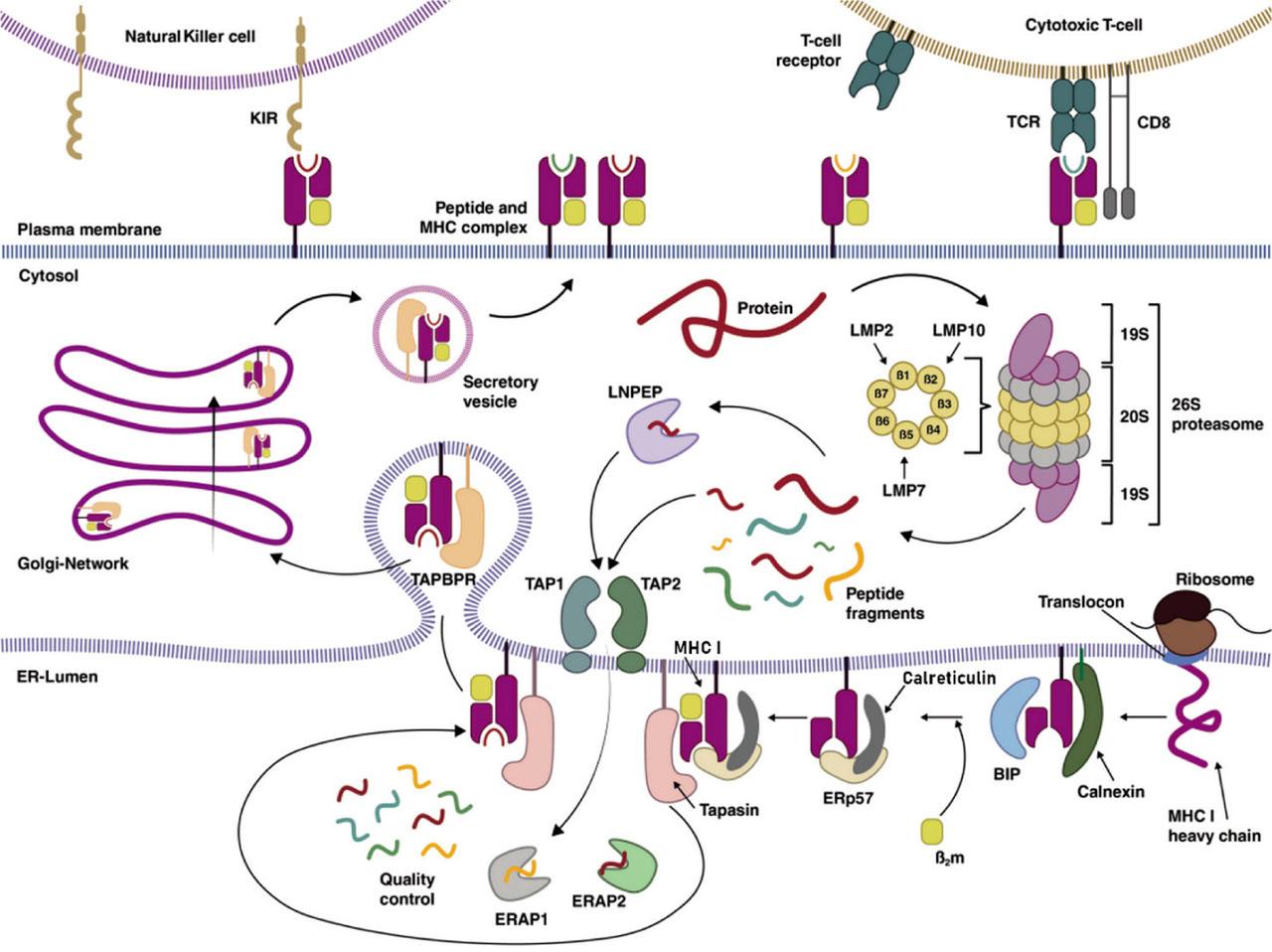Fig 1.

Elements of antigen processing machinery in the context of MHC I (in alphabetical order)
| Component | Full name | Function | References | |
|---|---|---|---|---|
| 1 | ERAP1 and ERAP2 |
| Trimming the antigenic peptides in the endoplasmic reticulum | Evnouchidou et al. (2014) and Evnouchidou and van Endert (2019) |
| 2 | LMP2, LMP7 and LMP10 | Immunoproteasome Low Molecular Weight Proteins 2, 7, and 10 | Processing of proteins to peptides in the cytosol | Ferrington and Gregerson (2012) and Leone et al. (2013) |
| 3 | LNPEP | Leucyl and Cystinyl Aminopeptidase | Trimming peptides in the cytosol | Agrawal and Brown (2014) and Segura et al. (2009) |
| 4 | MHC I | Major Histocompatibility Complex I | Presenting antigens to immune cells on the cell surface | Trowitzsch and Tampé (2020) |
| 5 | Tsn | Tapasin | Bridging the MHC I complex to transporters associated with antigen processing (TAP) | Thomas and Tampé (2017) |
| 6 | TAPBPR | TAP-Binding Protein-Related | Facilitating high-affinity epitope selection and peptide loading in the antigen presentation pathway | McShan et al. (2022) and Teng et al. (2002) |
| 7 | TAP1 and TAP2 | Transporter associated with Antigen Processing 1 and 2 | Transporting peptide precursors into the endoplasmic reticulum | Evnouchidou et al. (2014) and Evnouchidou and van Endert (2019) |
Experimental evidence of the relationship between HLA class I and endometriosis
| Objective | Methods | Results | References | |
|---|---|---|---|---|
| 1 | To investigate whether HLA-G polymorphisms may influence susceptibility to endometriosis and its progression |
|
| Bylińska et al. (2018) |
| 2 | To investigate an association between HLA-C genotype and the occurrence of endometriosis | - Sequence-based typing method | - The occurrence of HLA-C*03:03*01 was increased in endometriosis than in control groups | Chou et al. (2020) |
| 3 | To study the association between HLA genotypes and endometriosis | - PCR-MPH method | - Significant positive association with endometriosis was observed for HLA-B7 | Kitawaki et al. (2002) |
| 4 | To evaluate the sHLA-G levels in the blood sera of women with deep endometriosis and ovarian endometrioma throughout the menstrual cycle and to compare with the levels of sHLA-G in the blood sera of women with ovarian cancer | - ELISA test | - The level of sHLA-G concentration in the blood serum of patients with deep endometriosis fluctuates throughout the menstrual cycle, and during the proliferative and secretory phases, it remains at a high level comparable to that found in patients with ovarian cancer | Mach et al. (2010) |
| 5 | To assess whether the HLA-G is involved in the pathophysiology of endometriosis or disease progression |
|
| Rached et al. (2019) |
| 6 | To assess whether HLA class I expression on eutopic and ectopic endometrial cells modifies susceptibility to lymphocyte-mediated lysis |
| - The HLA-B7 allele inhibits the cytotoxic activity, suggesting that the growth of ectopic endometrial cells might be under a genetic control | Semino et al. (1995) |
| 7 | To compare the expression of HLA class I in endometrial samples from patients with and without endometriosis | - Immunohistochemical assays | - A significantly higher expression of HLA I in the endometriosis group than in controls, both in the glandular cells and in the stromal cells, was observed | Vernet-Tomás et al. (2006) |
| 8 | To explore the role of DNA methylation in endometriosis |
|
| Zhao et al. (2023) |